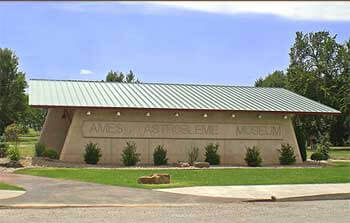Filter Places
The small, museum, which is without staff and open 24 hours, features high-tech, all-weather video panels on its north and south walls.
The panels describe the crater’s formation…and its geological significance, which was revealed by a leading independent producer in the early 1990s.
One of the videos includes comments from the man who defied the experts and discovered oil in the crater – Enid independent producer Harold Hamm, CEO of Continental Resources.
About 450 million years ago, a meteor struck north-central Oklahoma, creating an impact crater – an astrobleme – more than eight miles wide.
The Ames Crater impact site is one of six oil-producing craters in the United States.
As•tro•bleme (noun) – A depression, usually circular, on the surface of the Earth that is caused by the impact of a meteorite. From mid-20th century. astro- + Greek blçma “wound from a missile”
Today, the small. rural community of Ames proudly claims the crater as its own – and as an important contributor to the geological knowledge of the nation’s petroleum industry.
Located about 20 miles southwest of Enid, the Ames crater – an astrobleme – is buried by about 9,000 feet of sediment, making it barely visible on the surface. The hidden crater remained unrecognized until 1991, when a prolific oilfield was discovered.
Many geologists had believed impact craters unlikely locations for petroleum. Hamm, who had drilled wells in the Ames area since the early 1960s, thought otherwise. Although wells had been drilled nearby, no one had attempted to reach deep into the crater.
In 1991, a geologist at Continental Resources found something unusual in the site, so the company drilled a deeper than the normal well – about 10,000 feet – and struck oil. Initial production from this first well was about 200 barrels a day. Cumulative production figures through 2006 show production in the Ames crater area approaching 11 million barrels.

